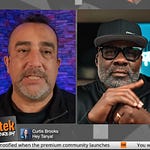Welcome to the final day of our Livestream Summer School! I’m Tanya Smith, and I’m thrilled to have you here with me as we wrap up this three-day event. If you’ve been with us since day one, thank you for your commitment! If you missed the earlier sessions, don’t worry; you can still catch up through the links available on my Substack page. Trust me, you won’t want to miss what we’ve covered!
Thank you
, , , , , and many others for tuning into my live video! Join me for my next live video in the app.Episode Overview
In today’s session, we’re diving deep into the art of communication on camera. Our focus is on “What to Say and How to Say It.” We’ll explore everything from crafting your message to overcoming camera anxiety, ensuring you present yourself confidently and authentically.
Here’s what we’ll cover:
Understanding Your Audience (0:02:30)
The Importance of Preparation (0:15:00)
Overcoming Camera Anxiety (0:30:00)
The HEART Framework for Structuring Your Content (0:45:00)
Engaging Your Viewers (1:00:00)
Q&A and Community Interaction (1:15:00)
1. Understanding Your Audience
Before we even think about what to say, we need to understand who we’re talking to. This is where the concept of the Most Valuable Video Viewer (MV3) comes into play. Who are the people that resonate with your message? Who will benefit from what you have to share? Knowing your audience is foundational. It allows you to tailor your content to meet their needs and expectations.
As you prepare to go live, take a moment to visualize your ideal viewer. What are their interests? What challenges do they face? When you have this clarity, your message will naturally become more focused and compelling.
2. Preparing Your Message
Now that you know your audience, let’s talk about what to say. It’s crucial to be intentional with your words. Remember, what you say shapes how you’re perceived. If you come across as unsure or vague, your audience will feel that uncertainty. Instead, aim for clarity and confidence in your delivery.
One key statistic to consider: according to a HubSpot survey in 2023, 89% of viewers believe a clear message is more important than video quality. So, even if your camera is acting up, focus on delivering a strong message. Your audience will appreciate it!
3. Overcoming Camera Anxiety
Let’s face it; being on camera can be nerve-wracking. Many people experience on-camera anxiety, which can manifest as freezing up, rambling, or even avoiding going live altogether. The good news is that this anxiety is normal, and there are ways to manage it.
Here’s a tip: practice makes progress. The more you put yourself out there, the more comfortable you’ll become. Start small—record short videos for yourself or go live with a trusted friend to build your confidence. Remember, it’s all about gradual exposure.
Another strategy is cognitive reframing. Challenge your inner critic! Instead of focusing on what went wrong, recognize your progress. Celebrate those small wins. Every time you go live, you’re gaining valuable experience that contributes to your growth.
4. The HEART Framework
To help you structure your livestreams, I want to introduce you to the HEART framework. This five-part model will guide you in crafting engaging content that resonates with your audience:
Hook: Grab attention in the first few seconds. Use a bold statement, a statistic, or a question to draw viewers in.
Engage: Create a connection by sharing relatable stories or values. Acknowledge your audience and encourage interaction.
Advance: Teach something meaningful that helps your viewers move from point A to point B.
Respond: Invite interaction by asking questions or encouraging comments. Make your audience feel heard.
Transform: End with a clear call to action. Encourage your viewers to take the next step, whether it’s subscribing, clicking a link, or joining a community.
5. Flow Over Perfection
Finally, let’s talk about the importance of flow. Many people get caught up in trying to be perfect on camera, but that can hinder your natural delivery. Instead of focusing on a word-for-word script, embrace your unique voice and style. If you’re passionate about what you’re talking about, that enthusiasm will shine through.
One useful tool can be a teleprompter, but remember, it’s not mandatory. If you choose to use one, ensure it complements your natural speaking style rather than detracting from it. Practice looking directly into the camera to create a more personal connection with your audience.
In Closing
We’ve covered a lot of ground—from understanding your audience to overcoming anxiety and utilizing the HEART framework. Remember, the key to successful livestreaming is not about being perfect; it’s about being present, prepared, and authentic.
Each time you go live, you’re building your skills and confidence.
As we wrap up this Livestream Summer School, I want to encourage you to take action. What topic could you go live about this week? Share your expertise, connect with your audience, and don’t be afraid to show up as your true self. The world needs your voice!
Thank you for joining me on this journey. If you enjoyed this session, please consider subscribing to my Livestream Archetypes quiz for more insights and tips.
Let’s continue to grow together!











